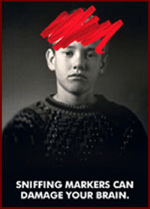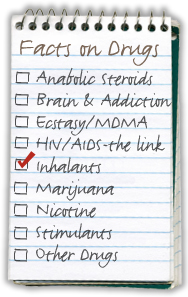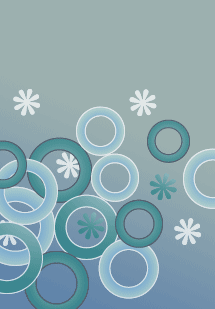Inhalants
What Are They?

Inhalants are breathable chemical vapors that produce psychoactive (mind-altering) effects. A variety of products common in the home and in the workplace contain substances that can be inhaled. Examples are some paints, glues, gasoline, and cleaning fluids. Many people do not think of these products as drugs because they were never meant to be used to achieve an intoxicating effect.
Although inhalants differ in their effects, they generally fall into the following categories:
Volatile Solvents, liquids that vaporize at room temperature, present in:
- certain industrial or household products, such as paint thinner, nail polish remover, degreaser, dry-cleaning fluid, gasoline, and contact cement
- some art or office supplies, such as correction fluid, felt-tip marker fluid, and electronic contact cleaner [1]
Aerosols, sprays that contain propellants and solvents, including:
- spray paint, hair spray, deodorant spray, vegetable oil sprays, and fabric protector spray
Gases, that may be in household or commercial products, or used as medical anesthetics, such as in:
- butane lighters, propane tanks, whipped cream dispensers, and refrigerant gases
- anesthesia, including ether, chloroform, halothane, and nitrous oxide [2]
What Are the Common Street Names?
Common slang for inhalants includes "laughing gas" (nitrous oxide), "snappers" (amyl nitrite), "poppers" (amyl nitrite and butyl nitrite), "whippets" (fluorinated hydrocarbons, found in whipped cream dispensers), "bold" (nitrites), and "rush" (nitrites).
Who Abuses Inhalants?
Inhalants are often among the first drugs that young children use. In fact, they are one of the few classes of substances that are abused more by younger children than older ones. Inhalant abuse can become chronic and persist into adulthood.
Data from national and state surveys suggest that inhalant abuse is most common among 7th- through 9th-graders. For example, in the Monitoring the Future Study, an annual NIDA-supported survey of the Nation's secondary school students, 8th-graders regularly report the highest rate of current, past-year, and lifetime inhalant abuse compared to 10th- and 12th-graders.
How Are They Abused?
Inhalants can be breathed in through the nose or mouth in a variety of ways: [2]
- "sniffing" or "snorting" fumes from containers
- spraying aerosols directly into the nose or mouth
- sniffing or inhaling fumes from substances sprayed or placed into a plastic or paper bag ("bagging")
- "huffing" from an inhalant-soaked rag stuffed in the mouth
- inhaling from balloons filled with nitrous oxide
Nitrites, a class of inhalants used primarily as sexual enhancers. Organic nitrites include amyl, butyl, and cyclohexyl nitrites and other related compounds. Amyl nitrite was used in the past to alleviate chest pain and is sometimes used today for diagnostic purposes in heart examinations. When marketed for illicit use, these nitrites are often sold in small brown bottles and labeled as “video head cleaner,” “room odorizer,” “leather cleaner,” or “liquid aroma.” [1]
[Back to top]Search.
Enter your keywords and click the button to submit the search.Need Treatment
Glossary
Exercise your brain
Free Downloads
Answer This
Mind Over Matter


